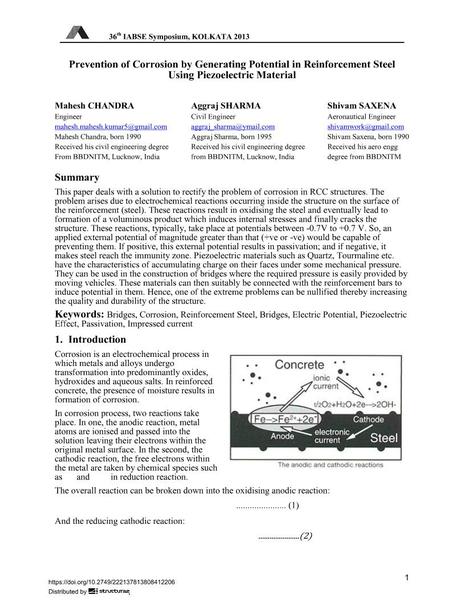Prevention of Corrosion by Generating Potential in Reinforcement Steel Using Piezoelectric Material

|
|
|||||||||||
Bibliografische Angaben
| Autor(en): |
Mahesh Chandra
Aggraj Sharma Shivam Saxena |
||||
|---|---|---|---|---|---|
| Medium: | Tagungsbeitrag | ||||
| Sprache(n): | Englisch | ||||
| Tagung: | IABSE Symposium: Long Span Bridges and Roofs - Development, Design and Implementation, Kolkata, India, 24-27 September 2013 | ||||
| Veröffentlicht in: | IABSE Symposium Kolkata 2013 | ||||
|
|||||
| Seite(n): | 1-4 | ||||
| Anzahl der Seiten (im PDF): | 4 | ||||
| Jahr: | 2013 | ||||
| DOI: | 10.2749/222137813808412206 | ||||
| Abstrakt: |
This paper deals with a solution to rectify the problem of corrosion in RCC structures. The problem arises due to electrochemical reactions occurring inside the structure on the surface of the reinforcement (steel). These reactions result in oxidising the steel and eventually lead to formation of a voluminous product which induces internal stresses and finally cracks the structure. These reactions, typically, take place at potentials between -0.7V to +0.7 V. So, an applied external potential of magnitude greater than that (+ve or -ve) would be capable of preventing them. If positive, this external potential results in passivation; and if negative, it makes steel reach the immunity zone. Piezoelectric materials such as Quartz, Tourmaline etc. have the characteristics of accumulating charge on their faces under some mechanical pressure. They can be used in the construction of bridges where the required pressure is easily provided by moving vehicles. These materials can then suitably be connected with the reinforcement bars to induce potential in them. Hence, one of the extreme problems can be nullified thereby increasing the quality and durability of the structure. |
||||
| Stichwörter: |
Brücken Korrosion reinforcement steel
|
||||
